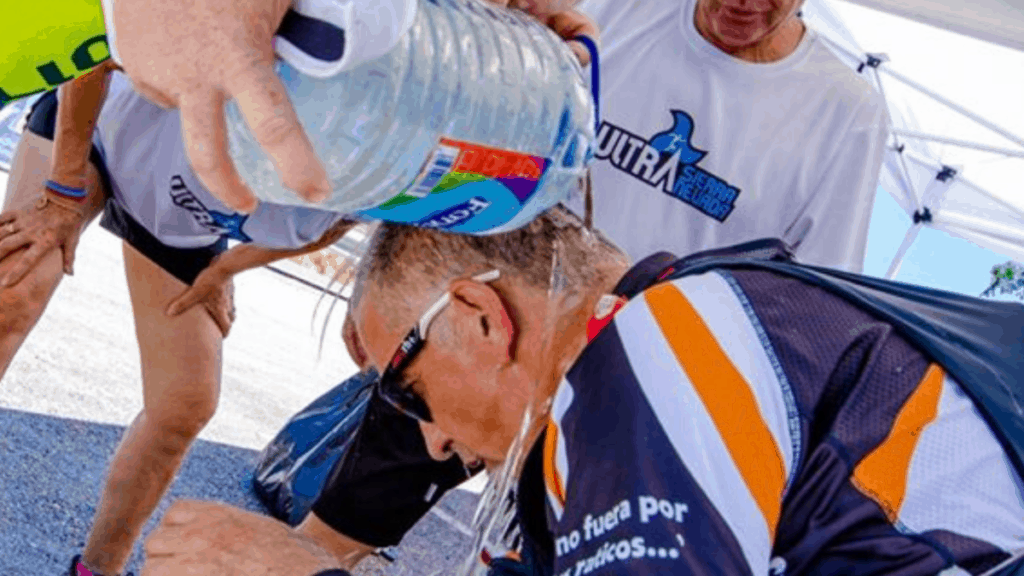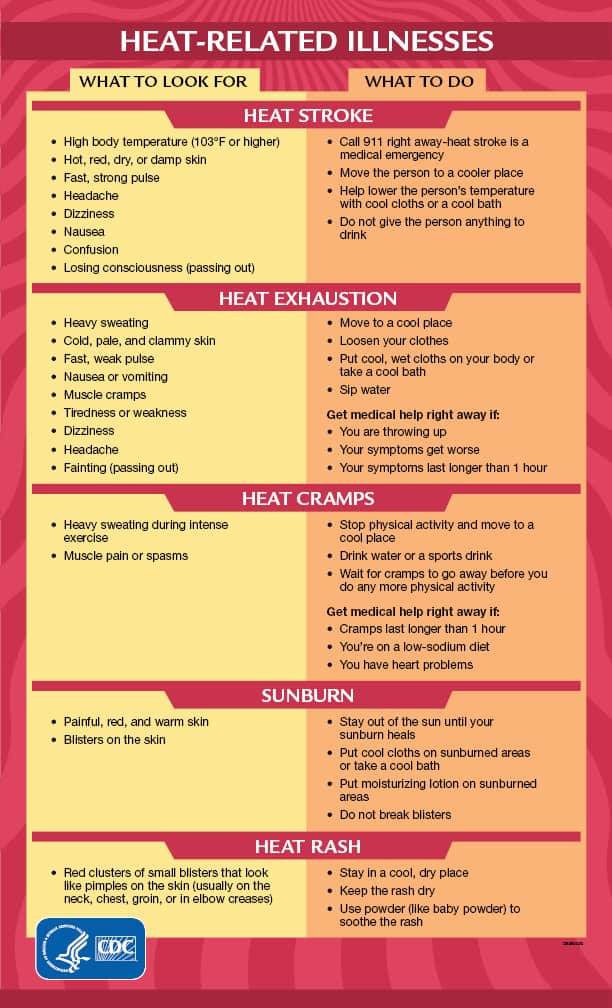
Summertime, when the weather is good and we can leave our warm layers at home when we head out for a run. However, that does not always mean that the living is easy out on the trails.
To be able to trail run in the heat your prerun planning will become more about how to manage your core temperature. Not only will elevated body temperature hinder your performance, but it can also in extreme cases be life-threatening.
In order to help you be able to trail run in the heat, here are 23 practical tips that you can apply the next time you head out on a hot day.
Don’t Neglect Your Warm-Up
Even though the weather may be warm, do not neglect your warm-up. Sure, you can reduce the duration and intensity of your warm-up but still do something.
Doing no warm-up at all will cause a sudden spike in your heart rate that will take ages to come back down in the heat – if it comes back down at all.
Manage Your Risk Of Heat Illnesses
Heat illness is a very real and serious condition that can have life-threatening consequences.
The CDC has published guidelines on what to do in the various stages of heat illness including a useful info-graphic that is shown below. Take the time to study it as it can save lives.

Adjust Your Pace To Effort Level
One of the side effects of running in the heat is that your heart rate will be elevated.
This means that it will take greater effort to run at the same pace as you would in cooler conditions.
Therefore what I do is adjust my pace down so that I match my effort level.
I learned this from high school athletics. A standard workout would be 4 sets of 4 x 300m sprints with a 100m jog between each sprint and a 5-minute rest between sets. When the temperature got above 95 degrees our coach would reduce it down to 3 sets of 3 x 300m sprints with a 10-minute rest between sets to cool off.
Run Early In the Morning Or Late In The Evening
The general suggestion is to choose the late evening or early morning. Personally, of those two, I normally choose an early morning run for a number of reasons.
The first is that if you look at a temperature graph, almost always the coolest hour of the day is the hour immediately before sunrise.
Another cool thing about doing an early morning run is that I am finished just as the world around me is starting to awaken and I find that super motivating for the rest of my day.
Whether you get your run in during the late evening or early morning it is going to involve running during dusky conditions. Luckily I have an article for you that is all about how to trail run at dusk. Be sure to check that out.
To Be Ready For An Early Run Eat And Sleep Early The day Before
If you are going to head out really early to get your run finished before the heat gets too bad, be sure to eat and sleep early the night before.
Eating early enough will do more than just make sure that you rest better when you go to bed. The digestion process produces body heat and that can prevent you from bringing your core temperature down overnight.
Head For Altitude Where The Air Is Cooler
As you head up to higher altitude the air gets cooler at a rate of 3.56 degrees per 1.000ft (6.49C per 1.000m) for static air and 5.38 degrees per 1.000ft (9.8C per 1.000m) for a rising pocket of air.
That is why I always try to do my altitude training camps during the height of summer. That way I can get my altitude training and escape the heat.
For more on altitude training, here is the article that I wrote that explains how altitude training makes you a faster trail runner.
Split A Long Run Into Two Shorter Runs
Something else that I have done and can work well when the weather gets really hot is to split your long run of 90 minutes or more into two runs where you can allow your body to cool properly between runs.
What works for me is to split the workout into my longer and slower workout in the early morning and then do the interval or hill session later.
Look For Shade Along Your Run
One of the benefits of an early or late run is that the chances are greater that shadows will be longer and that more of the trail will be in the shade.
While running, seek out shady spots for respite from the heat of the direct sun.
Avoid Heat If You Are Still Unfit
Your ability to cope with the heat improves as you get fitter.
Therefore, if you are just starting out do not head out in the heat as you do not yet have the fitness to manage your core temperature. This could have serious health consequences.
Hydrate Well But Within Limits
Staying well-hydrated does not just apply to during your runs but throughout the day. If you start your run well hydrated it is easier to keep from getting dehydrated without over-drinking.
I covered the effects of over-hydrating in great detail in my article all about why your hands swell when you run. Go and give it a read.
Freeze A Water Bottle And Carry It In Your Hand
Something that is surprisingly effective at bringing down your core temperature is to carry a frozen water bottle. This helps in three ways.
The obvious way is that by holding something frozen in your hand will cool you down. In addition, as the ice melts you will be sipping ice-cold water. Finally, the speed at which the ice melts will prevent you from over drinking.
I put this to the test when I raced an XTERRA triathlon in the hottest month of summer. By the time I finished the mountain biking and started on the trail run the temperature was nudging past 105 degrees.
Having an ice bottle in my hand brought my core temperature back down even the first part of the run was uphill in the full sun.
Incorporate Heat Acclimation Training
Many athletes, especially those that live in colder climates use a sauna as a means to acclimate to the heat. In some cases athletes us a sauna provided by their gym while others have a sauna at their house.
Canadian Ironman triathlete Lionel Sanders has taken it a step further in his preparations for the heat and humidity of Hawaii by setting up his treadmill inside the sauna.
These are the key reasons why athletes use the heat acclimation of their sauna:
- Lowers core body temperature.
- Lowers heart rate during exercise.
- Increase your sweat rate.
- Develop your sweat glands.
- Improved VO2 max.
- Increases blood plasma volume.
- Enhances blood delivery to the skin.
Keep Your Head And Neck Cool
Your head and the back of your neck are the two areas of your body where you are able to dissipate the most heat.
Do whatever you can to keep these two areas of your body cool as the temperature ramps up.
Sponge Or Pour Water Over Your Body At Aid Stations
During a race, use your time at aid stations to get as much water over your body as possible when conditions are really hot.
Remember it is the process of that water evaporating between aid stations that will be cooling you down.
Don’t Forget Your Sunglasses
I know that boosting your vitamin D is important. However, damaging your eyes from UV radiation and sun glare are more serious and permanent. So wear your shades.
Wear A hat Or Bandanna To protect your head and neck
This holds especially true when you are on a trail that offers you no shade at all wearing a hat or a bandanna can be your own portable shade. That way you can protect your head and neck.
Put Ice Cubes In Your Hat
This is something that I have done in races many times. If there is ice at the aid station I will fill up my hat with ice and put that on my head to cool down.
During my triathlon days, I would sometimes see female athletes dropping some ice into their sports bras at aid stations which would also help bring their core temperature down.
Dress As Lightly As Legally Possible
For me, this usually involves wearing as little as I can legally get away with. If you do strip down a bit more than normal be sure to use sunblock on any areas of your skin that are more sensitive to sun and UV exposure.
Wear Loose Fitting Clothes In Technical Fabric
Any clothing that you do wear should ideally be loose fitting to allow air to circulate, keeping you cooler.
Technical fabrics allow moisture to evaporate faster and evaporation causes cooling as my eighth-grade science teacher taught me.
For A short Run Splash More Water Than You Drink
When you run is short and your general hydration level is good, there is no great need to drink a lot during your short run. The simple truth is that your run will be finished before the water has had a chance to clear from your stomach.
Instead you will do a lot better by splashing most of the water out over you.
Run Shorter Loops Near A Water Source
This is something that I have done more than once during my long run. Instead of doing one long loop for my long run, I will seek out a water source where I can drink and splash enough water over me.
I will then do multiple short loops that come back to that water source so that I am never more than a couple of minutes away from water.
Stay Hydrated Throughout The Day
This is something that was drilled into me by my high school athletics coach and that was to stay hydrated throughout the day.
We were told that the only time when it was ok not to have water on hand and to be drinking was when we were going to the bathroom.
Maybe this was a little excessive, but it carried the point across.
Do The First Half Of Your Run Downwind
I know that this last tip might sound counter intuitive.
This holds especially true when you do your run early in the day as the temperatures are still warming.
When you run downwind you are moving in the same direction as the airflow which effectively nullifies the cooling airflow that you feel. Think about it almost like running on the treadmill without any fans on, your core temperature elevates very quickly.
Then, when you turn for the second half of your run you suddenly feel the cooling breeze in your face.
This made a big difference in my training and stopped me overheating badly in the second half of the run.
